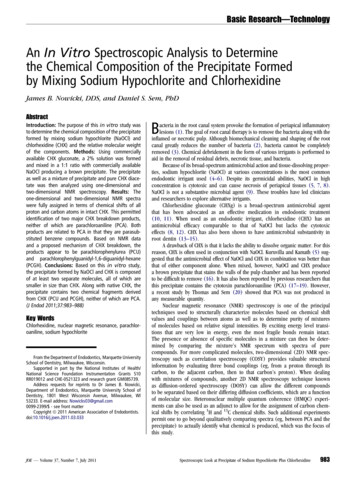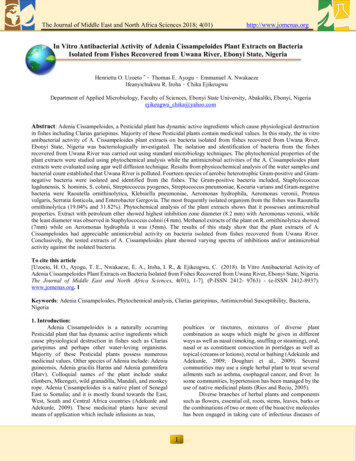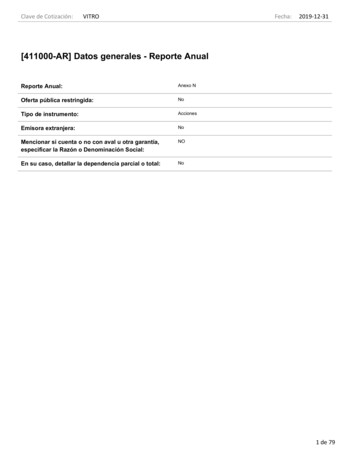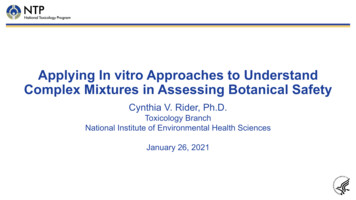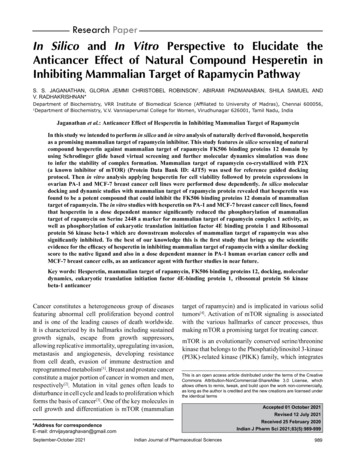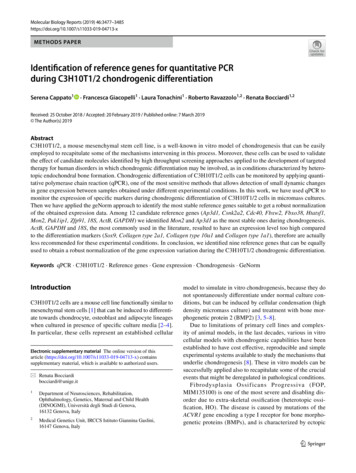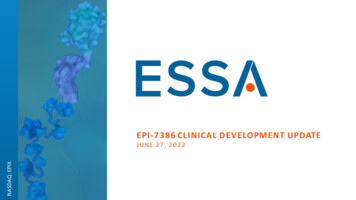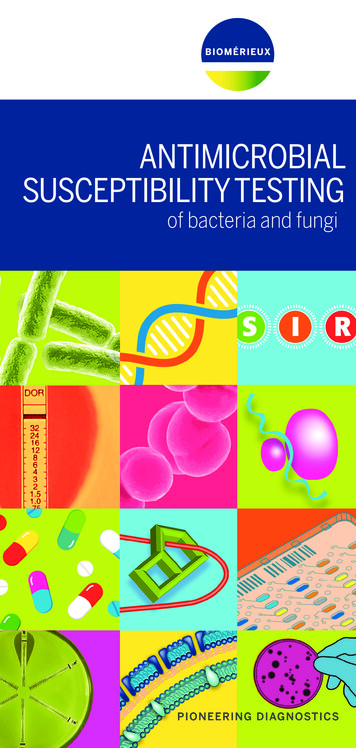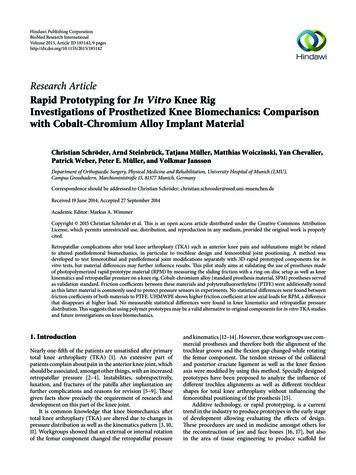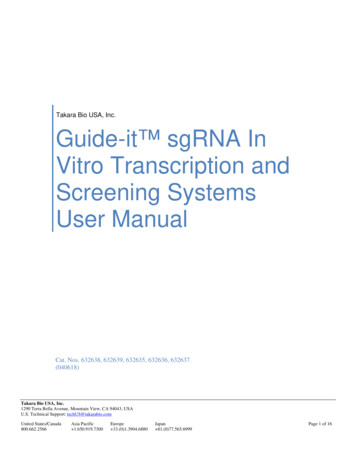
Transcription
Takara Bio USA, Inc.Guide-it sgRNA InVitro Transcription andScreening SystemsUser ManualCat. Nos. 632638, 632639, 632635, 632636, 632637(040618)Takara Bio USA, Inc.1290 Terra Bella Avenue, Mountain View, CA 94043, USAU.S. Technical Support: techUS@takarabio.comUnited States/Canada800.662.2566Asia Pacific 1.650.919.7300Europe 33.(0)1.3904.6880Japan 81.(0)77.565.6999Page 1 of 16
Guide-it sgRNA In Vitro Transcription and Screening Systems User ManualTable of ContentsI.Introduction . 3A.Summary . 3B.Protocol Overview . 5II.List of Components . 6III.Additional Materials Required . 7IV.In Vitro Transcription of an sgRNA Containing the Desired Target Sequence . 8A.V.Guidelines for Designing PCR Primers . 8Protocol: In Vitro Transcription of sgRNA . 10A.PCR Amplification of sgRNA Template . 10B.In Vitro Transcription (IVT) Reaction . 11VI.Protocol: Purification of Transcribed sgRNA . 12VII.Protocol: Screening sgRNAs for Effective Cleavage of their Targets . 13A.Extraction of Genomic DNA (Individual Sample Method) . 13B.Extraction of Genomic DNA (Plate Method) . 13C.PCR Amplification of Target DNA . 14D.Cas9 Cleavage Assay . 15Table of FiguresFigure 1. Using Guide-it technology to perform genome editing. . 4Figure 2. Guide-it Complete sgRNA Screening System protocol. . 5Figure 3. Designing a forward PCR primer to generate a DNA template for an sgRNA containing your target sequence. . 9Figure 4. Gel electrophoresis of the PCR product. . 10Figure 5. sgRNA yield over time with the Guide-it sgRNA In Vitro Transcription Kit. . 11Figure 6. PCR amplicon design. . 14Figure 7. Analysis of cleavage products. . 16Table of TablesTable I. Examples of sgRNA concentration and yield using different elution volumes. . 12Table II. Reference volumes for genomic DNA extraction. . 13(04/06/18)takarabio.comTakara Bio USA, Inc.Page 2 of 16
Guide-it sgRNA In Vitro Transcription and Screening Systems User ManualI.IntroductionA.SummaryCRISPR/Cas9 is a breakthrough genome editing technology that permits site-specific cleavage of DNAtargets in the genomes of various organisms and mammalian cells. Disruptive mutations are created atthose cleavage sites by error-prone repair or by using homologous recombination to change or insertsequences. The power of this technology derives from its simplicity, since all it requires is a Cas9nuclease enzyme combined with a single guide RNA (sgRNA) that determines its target specificity. EachsgRNA is designed by the user to contain a short sequence homologous to a target sequence of choice,with which it directs the Cas9 nuclease to introduce a double-stranded break at that sequence (Figure 1).This user manual describes how to use the following kits:(04/06/18) The Guide-it sgRNA In Vitro Transcription Kit (Cat. No. 632635) is used to produce highyields of sgRNAs following in vitro transcription (IVT) reactions. This kit includes the Guide-itIVT RNA Clean-Up Kit (Cat. No. 632638) to purify sgRNA for direct use in transfection,electroporation, or in vitro cleavage assays. The Guide-it IVT RNA Clean-Up Kit (Cat. No. 632638) is a phenol-free kit used to purifysgRNA following in vitro transcription (IVT) reactions. The purified sgRNA is ready for use intransfection, electroporation, or in vitro cleavage assays. The Guide-it sgRNA Screening Kit (Cat. No. 632639) enables the user to test the efficacy ofdifferent sgRNAs in vitro prior to using them in studies involving Cas9-mediated gene editing.With this kit, a template containing an sgRNA target site is created by PCR, then combined withan sgRNA that you wish to test and Cas9 nuclease. The efficiency with which Cas9 nucleasecleaves the template can be measured using agarose gel electrophoresis. The Guide-it Complete sgRNA Screening System (Cat. No. 632636) is a combination of theGuide-it sgRNA In Vitro Transcription Kit (Cat. No. 632635) and Guide-it sgRNA ScreeningKit (Cat. No. 632639) described above and is used to produce and test the efficacy of sgRNAs.The kit contains all of the components needed to in vitro transcribe sgRNAs, purify the sgRNAs,and test their efficacy against a PCR target fragment using recombinant Cas9 nuclease.takarabio.comTakara Bio USA, Inc.Page 3 of 16
Guide-it sgRNA In Vitro Transcription and Screening Systems User ManualFigure 1. Using Guide-it technology to perform genome editing. An sgRNA consists of a single RNA strand with a crRNA sequencethat binds to a specific DNA target, and a tracrRNA sequence that binds to Cas9 protein. When an sgRNA engineered to contain a 20nucleotide (nt) target sequence of interest binds to a recombinant form of Cas9 protein that has double-stranded DNA endonucleaseactivity, the resulting complex will produce target-specific double-stranded cleavage. Cellular repair, which is error-prone, will take placeat the cleavage site, and may result in a mutation that can knock out a gene.(04/06/18)takarabio.comTakara Bio USA, Inc.Page 4 of 16
Guide-it sgRNA In Vitro Transcription and Screening Systems User ManualB.Protocol OverviewStep 1Step 2Step 3Step 4Step 5Step 6Use PCR togenerate ansgRNAencodingtemplateIn vitrotranscribesgRNAfrom thetemplatePurify andquantify thesgRNA viaspin columnUse PCR tocreate aDNAcleavagetemplatePerformcleavagereactionswith Cas9sgRNAAnalyzecleavageefficiencyon anagarose gelGuide-it IVTRNA CleanUp KitGuide-it sgRNA In Vitro Transcription KitGuide-it sgRNA Screening KitGuide-it Complete sgRNA Screening SystemFigure 2. Guide-it Complete sgRNA Screening System protocol.The Guide-it Complete sgRNA Screening System can be used to synthesize and test the efficacy ofsgRNAs as follows (Figure 2):1. Generate a DNA template that contains your sgRNA-encoding sequence under the control of aT7 promoter by performing a PCR reaction with the included Guide-it Scaffold Template and aprimer you design (Section V.A).2. In vitro transcribe this template with the included Guide-it T7 Polymerase Mix to create ansgRNA containing your target sequence (Section V.B).3. Purify your sgRNA after digestion with Recombinant DNase I (RNase-Free) using the Guide-itIVT RNA Clean-Up Kit; and measure its concentration using a NanoDrop 2000spectrophotometer or equivalent (Section VI).4. Create a cleavage template for screening your purified sgRNA by amplifying a 600- to 800-bpfragment of genomic DNA that contains your target sequence in an asymmetric position that willproduce two cleavage fragments of unequal size (Sections VII.A–C).5. Perform a cleavage reaction on this template using your purified sgRNA in combination with theincluded Guide-it Recombinant Cas9 Nuclease (Section VII.D).6. Analyze the efficiency of your cleavage reactions on an agarose gel to determine if your targetsequence was successfully incorporated (Section VII.D).(04/06/18)takarabio.comTakara Bio USA, Inc.Page 5 of 16
Guide-it sgRNA In Vitro Transcription and Screening Systems User ManualII.List of Components Store Guide-it IVT RNA Clean-Up Kit at room temperature. Store all other components at –20 C. Avoid repeated freeze/thaw cycles.Guide-it sgRNA In Vitro Transcription Kit (Cat. No. 632635; 50 rxns)Guide-it sgRNA In Vitro Transcription Components v2 (Cat. No. 632637; 50 rxns; Not sold separately)50 µl Guide-it Scaffold Template (1 ng/µl)350 µl Guide-it In Vitro Transcription Buffer1 ml RNase Free Water150 µl Guide-it T7 Polymerase Mix (33 U/µl)625 µl PrimeSTAR Max Premix (2X)100 µl Recombinant DNase I (RNase-Free) (5 U/µl)Guide-it IVT RNA Clean-Up Kit (Cat. No. 632638; 50 rxns)13 ml RNase Free Water3 ml IVT Binding Buffer50 columns IVT RNA Clean-Up Spin Columns2 x 6 ml IVT Wash Buffer50 tubes Collection Tubes (2 ml)Guide-it IVT RNA Clean-Up Kit (Cat. No. 632638; 50 rxns)13 ml RNase Free Water3 ml IVT Binding Buffer50 columns IVT RNA Clean-Up Spin Columns2 x 6 ml IVT Wash Buffer50 tubes Collection Tubes (2 ml)Guide-it sgRNA Screening Kit (Cat. No. 632639; 50 rxns)25 µl Guide-it Recombinant Cas9 Nuclease (500 ng/µl)50 µl 15X Cas9 Reaction Buffer50 µl 15X BSA15 µl Control sgRNA (50 ng/µl)150 µl Control Fragment (20 ng/µl)50 µl Terra PCR Direct Polymerase Mix (1.25 U/µl)1.25 ml 2X Terra PCR Direct Buffer (with Mg2 , dNTP)5 ml RNase Free Water5 ml Extraction Buffer 10.5 ml Extraction Buffer 2(04/06/18)takarabio.comTakara Bio USA, Inc.Page 6 of 16
Guide-it sgRNA In Vitro Transcription and Screening Systems User ManualGuide-it Complete sgRNA Screening System (Cat. No. 632636; 50 rxns)Guide-it sgRNA In Vitro Transcription Components v2 (Cat. No. 632637; 50 rxns; Not sold separately)50 µl Guide-it Scaffold Template (1 ng/µl)350 µl Guide-it In Vitro Transcription Buffer1 ml RNase Free Water150 µl Guide-it T7 Polymerase Mix (33 U/µl)625 µl PrimeSTAR Max Premix (2X)100 µl Recombinant DNase I (RNase-Free) (5 U/µl)Guide-it IVT RNA Clean-Up Kit (Cat. No. 632638; 50 rxns)13 ml RNase Free Water3 ml IVT Binding Buffer50 columns IVT RNA Clean-Up Spin Columns2 x 6 ml IVT Wash Buffer50 tubes Collection Tubes (2 ml)Guide-it sgRNA Screening Kit (Cat. No. 632639; 50 rxns)25 µl Guide-it Recombinant Cas9 Nuclease (500 ng/µl)50 µl 15X Cas9 Reaction Buffer50 µl 15X BSA15 µl Control sgRNA (50 ng/µl)150 µl Control Fragment (20 ng/µl)50 µl Terra PCR Direct Polymerase Mix (1.25 U/µl)1.25 ml 2X Terra PCR Direct Buffer (with Mg2 , dNTP)5 ml RNase Free Water5 ml Extraction Buffer 10.5 ml Extraction Buffer 2III.Additional Materials RequiredThe following materials are required but not supplied: 96–100% ethanol Isopropanol 1.5-ml microcentrifuge tubes 200-µl PCR tubes NanoDrop 2000 spectrophotometer (Thermo Fisher Scientific, Cat. No. ND-2000) or equivalent(04/06/18)takarabio.comTakara Bio USA, Inc.Page 7 of 16
Guide-it sgRNA In Vitro Transcription and Screening Systems User ManualIV.In Vitro Transcription of an sgRNA Containing the Desired Target SequenceCreate an sgRNA containing your target sequence as follows:1. Using the included Guide-it Scaffold Template and a primer you design (Section IV.A), PCR amplify aDNA template that contains your sgRNA encoding sequence under the control of a T7 promoter (SectionV.A).2. Perform an in vitro transcription reaction with the PCR product from Step 1 to generate your sgRNA(Section V.B), then purify and quantify the newly synthesized sgRNA (Section VI.A).A.Guidelines for Designing PCR PrimersUse the following guidelines to design a forward primer to be used in a PCR reaction with the included Guide-itScaffold Template to create a DNA template for in vitro transcription of your sgRNA. This primer should containthe T7 promoter sequence, followed by your sgRNA target sequence, and the Guide-it Scaffold Template-specificsequence (Figure 3).Choosing the correct DNA target sequenceChoose the DNA target sequence that will correspond to your actual sgRNA target sequence as shown inFigure 3, Panel A, according to the following guidelines:a. The DNA target sequence you choose must end with the proto-spacer adjacent motif (PAM)sequence, NGG, on its 3’ end. Only DNA sequences that are 20 nucleotides upstream of a PAMsequence can be used for CRISPR/Cas9.b. Any target sequence can be used if the sequence is followed by the PAM sequence, NGG.However, to minimize off-target cleavage events, the entire target sequence (including the PAM)should have at least three base mismatches with any other non-targeted genomic sequence. Offtarget events should be especially low if the mismatches are in, or adjacent to, the PAM. Themajority of online tools for sgRNA design will predict off-target sequences for a given sgRNAtarget sequence. To learn more, visit ng a 56- to 58-nt forward PCR primerThe forward (sense) primer must contain the following four sequence elements, as shown in Figure 3,Panel B.a. A T7 promoter sequence plus four extra bases (21 total nt) at the 5’ end of the primer.b. A transcription initiation site (0–2 guanine (G) residues): The number of Gs added is dependenton the 5’ end of the target sequence. The T7 promoter requires at least two Gs for efficienttranscription.NOTE: If your specific target sequence (see item c, below) already contains two Gs, there is noneed to add extra Gs for transcription initiation. Extra Gs could reduce cleavage efficiency.c. Your specific sgRNA target sequence (20 nt).d. The Guide-it Scaffold Template-annealing sequence (15 nt at the 3’end of the primer)NOTES: A reverse (antisense) primer comes premixed with the Guide-it Scaffold Template. The forward primer should be subjected to salt-free purification following synthesis and diluted to aconcentration of 10 µM in PCR-grade water.(04/06/18)takarabio.comTakara Bio USA, Inc.Page 8 of 16
Guide-it sgRNA In Vitro Transcription and Screening Systems User ManualFigure 3. Designing a forward PCR primer to generate a DNA template for an sgRNA containing your target sequence. Panel A.Choose the DNA target sequence that will correspond to your actual sgRNA target sequence. Panel B. Design the forward primer tocreate the in vitro transcription template you will use to generate your sgRNA. Do not include the PAM sequence between your 20 bptarget sequence and the Scaffold Template annealing sequence. (NOTE: The T7 promoter sequence (with four extra bases) and theScaffold Template-specific sequence do not change.)(04/06/18)takarabio.comTakara Bio USA, Inc.Page 9 of 16
Guide-it sgRNA In Vitro Transcription and Screening Systems User ManualV.Protocol: In Vitro Transcription of sgRNAFor use with the Guide-it sgRNA In Vitro Transcription Kit.A.PCR Amplification of sgRNA Template1. Combine the following components in a 200-µl PCR tube. Briefly vortex and spin down to collect thereagents at the bottom of the tube.ReagentPrimeSTAR Max Premix (2X)Guide-it Scaffold TemplateYour forward primer (10 µM)RNase Free WaterTotalAmount (µl)12.510.511252. Place reactions in a preheated thermal cycler with a heated lid and run the following program:33 cycles:98 C68 C4 C10 sec10 secforever3. Run and analyze 5 µl of the PCR product on a 2% agarose gel with a 100-bp DNA ladder. Youshould see a single band at 130 bp (see Figure 4).Figure 4. Gel electrophoresis of the PCR product. M 100-bp DNA ladder. S 5 µl of sample.(04/06/18)takarabio.comTakara Bio USA, Inc.Page 10 of 16
Guide-it sgRNA In Vitro Transcription and Screening Systems User ManualB.In Vitro Transcription (IVT) ReactionThe PCR product amplified in Section V.A Step 2 is directly used as template for the IVT reactionwithout purification.1. Combine the following components in a 200-µl PCR tube. Briefly vortex and spin down to collect thereagents at the bottom of the tube.ReagentsgRNA PCR template (Step A2)Guide-it In Vitro Transcription BufferGuide-it T7 Polymerase MixRNase Free WaterTotalAmount (µl)573520NOTE: If you require a higher amount of sgRNA, you can scale up the total reaction size (e.g., to 50µl) without changing the quality of the sgRNA.2. Place reactions in a preheated thermal cycler with a heated lid and run the following program:37 C4 C4 hrforeverNOTE: We recommend a 4-hr incubation, but a shorter incubation time is acceptable if you do notneed to maximize your sgRNA yield (see Figure 5). We have observed a clear, sharp band via AgilentBioanalyzer following 8 hr of incubation, indicating no drop in sgRNA quality.Figure 5. sgRNA yield over time with the Guide-it sgRNA In Vitro Transcription Kit. 20 µl of sgRNA IVT reactionswere incubated for different times at 37 C. The reactions were purified using the Guide-it IVT RNA Clean-Up Kit andquantified using a NanoDrop spectrophotometer.(04/06/18)takarabio.comTakara Bio USA, Inc.Page 11 of 16
Guide-it sgRNA In Vitro Transcription and Screening Systems User Manual3. Following incubation, add 2 µl of Recombinant DNase I (RNase-Free) to the 20-µl IVT reaction.Briefly vortex and spin down to collect the reagents at the bottom of the tube.4. Place reactions in a preheated thermal cycler with a heated lid and run the following program:37 C4 CVI.15 minforeverProtocol: Purification of Transcribed sgRNAFor use with the Guide-it IVT RNA Clean-Up Kit.NOTE: Before purifying your sgRNA, prepare the IVT Wash Buffer by adding 24 ml of 96–100% ethanol.1. Add 78 µl of RNase Free Water to the reaction mixture (Section V, Step B4) for a total volume of 100 µl.Transfer all 100 µl to a 1.5-ml microcentrifuge tube.2. Add 30 µl of IVT Binding Buffer and vortex for 5 sec.3. Add 130 µl of isopropanol and vortex for 5 sec.4. Place an IVT RNA Clean-Up Spin Column in a Collection Tube and load the sample from Step 3 onto thecolumn. Centrifuge at 11,000g for 30 sec at room temperature.5. Discard the flowthrough and place the column back in the Collection Tube.6. Add 600 µl of IVT Wash Buffer and centrifuge at 11,000g for 30 sec at room temperature.7. Discard the flowthrough and place the column back in the Collection tube.8. Add 250 µl of IVT Wash Buffer and centrifuge at 11,000g for 2 min at room temperature.9. Place the IVT RNA Clean-Up Spin Column in a new 1.5-ml microcentrifuge tube.10. Add 20 µl of RNase Free Water directly onto the silica membrane of the Spin Column and incubate for 1 minat room temperature.NOTE: With an elution volume of 20 µl, a concentration of 0.5 µg/µl is expected. This is appropriate forapplications such as transfection, electroporation, and in vitro cleavage assay. If you need a higherconcentration of sgRNA, the elution volume can be reduced down to 5 µl (see Table I, below).Table I. Examples of sgRNA concentration and yield using different elution volumes. Different elution volumes were used forpurification of sgRNA using the Guide-it IVT RNA Clean-Up Kit. A smaller elution volume can be used without a significant loss oftotal yield of sgRNA if the higher sgRNA concentration is required for your experiment.Elution volumeConcentrationYield5 µl2.2 µg/µl11.2 µg10 µl1.3 µg/µl12.8 µg20 µl0.7 µg/µl13.2 µg11. Centrifuge at 11,000g for 1 min at room temperature.12. Use 1 µl to measure the OD using a NanoDrop Spectrophotometer (or equivalent). A yield of 10–20 µg ofsgRNA is expected.(04/06/18)takarabio.comTakara Bio USA, Inc.Page 12 of 16
Guide-it sgRNA In Vitro Transcription and Screening Systems User ManualVII.Protocol: Screening sgRNAs for Effective Cleavage of their TargetsFor use with the Guide-it sgRNA Screening Kit.NOTE: The screening kit includes sufficient reagents for 50 preps of genomic DNA in a 48-well format. Choosea format appropriate for your cells and use the appropriate method below (Section A or B) for DNA extraction.Cells that are 50–90% confluent are preferred.A.Extraction of Genomic DNA (Individual Sample Method)In this method, cells are harvested from wells prior to crude DNA extraction.1. Harvest your cells from their individual wells and add an appropriate volume of Extraction Buffer 1to the cell pellet, depending on the plate type used (see Table II, below). Vortex briefly.2. Incubate at 95 C for 10 min.3. Add an appropriate volume of Extraction Buffer 2 (see Table II, below). Vortex briefly.4. Dilute the lysate (Step 3) 1:9 with RNase Free Water (e.g., 5 µl of lysate 45 µl of RNase FreeWater).NOTE: Depending on the amplification efficiency of the target, a range of dilutions (from undilutedto 1:50) may be required to achieve clear amplification results.5. The diluted lysate contains genomic DNA and will be used directly for PCR (Section VIIC).B.Extraction of Genomic DNA (Plate Method)In this method, crude DNA extracts are prepared directly from cells while in the plate wells.1. Remove the medium from the wells of the plate. Add an appropriate volume of Extraction Buffer 1(see Table II, below).2. Incubate at 70 C for 10 min.3. Vortex for 5 min.4. Add an appropriate volume of Extraction Buffer 2 (see Table II, below) and vortex for 30 sec.5. Move the lysate (Step 3) to a fresh 1.5-ml microcentrifuge tube.6. Dilute the lysate 1:9 with RNase Free Water (e.g., 5 µl of lysate 45 µl of RNase Free Water).NOTE: Depending on the amplification efficiency of the target, a range of dilutions (from undilutedto 1:50) may be required to achieve clear amplification results.7. The diluted lysate contains genomic DNA and will be used directly for PCR (Section VIIC).Table II. Reference volumes for genomic DNA extraction.Plate type (wells)Extraction Buffer 1Extraction Buffer 2(04/06/18)9636 µl4 µltakarabio.comTakara Bio USA, Inc.4890 µl10 µl24180 µl20 µl12360 µl40 µlPage 13 of 16
Guide-it sgRNA In Vitro Transcription and Screening Systems User ManualC.PCR Amplification of Target DNA1. Design primers to amplify the region targeted by CRISPR/Cas9. The optimal amplicon size is600–800 bp, with the sgRNA target sequence located asymmetrically within the amplicon; eachcleavage fragment should be at least 250 bp, and there should be a 100 bp size difference betweenthe fragments after Cas9 cleavage (Figure 6). These guidelines ensure efficient amplification andgood assay resolution.Figure 6. PCR amplicon design.2. Combine the following components in a 200-µl PCR tube. Briefly vortex and spin down to collect thereagents at the bottom of the tube.Reagent2X Terra PCR Direct Buffer (with Mg2 , dNTP)Forward primer (10 µM)Reverse primer (10 µM)Terra PCR Direct Polymerase Mix (1.25 U/µl)RNase Free WaterPrepared lysate (Section VIIA, Step 5 or Section VIIB Step 7)TotalAmount (µl)251.51.51192503. Place reactions in a preheated thermal cycler with a heated lid and run the following program:98 C30–40 cycles:98 C60 C68 C4 C2 min10 sec15 sec1 min/kbforeverNOTE: Adjustments to the cycling conditions may be necessary, depending on your target fragment.4. Use 5 µl of the PCR product for agarose gel electrophoresis; run the sample on a 1.5–2% agarose gel.NOTE: Make sure that your PCR yields a strong, single band; 100–250 ng of PCR product (in avolume of 5 µl) will be required for the subsequent Cas9 cleavage assay. Using this amount ensuresthat the bands remain easily visible after the cleavage assay without overwhelming the Cas9/sgRNA.(04/06/18)takarabio.comTakara Bio USA, Inc.Page 14 of 16
Guide-it sgRNA In Vitro Transcription and Screening Systems User ManualD.Cas9 Cleavage Assay1. Combine the following components in a 200-µl PCR tube. If you have multiple samples, make amaster mix.ReagentTarget-specific sgRNA (50 ng/µl) or Control sgRNA (50 ng/µl)Guide-it Recombinant Cas9 Nuclease (500 ng/µl)TotalAmount (µl)10.51.52. Mix well, very gently, by pipetting. Incubate using a thermal cycler with the following conditions:37 C4 C5 minforever3. Combine the following components in a 200-µl PCR tube in the order listed. If you have multiplesamples, make a master mix.NOTE: The volume of PCR sample used should not exceed 5 µl; carryover of PCR reaction buffermight inhibit Cas9 activity. The optimal range of DNA input is 100–250 ng.ReagentPCR reaction solution (100–250 ng) or Control Fragment15X Cas9 Reaction Buffer15X BSARNase Free WaterCas9/sgRNA mix (from Step 2 above)TotalAmount (µl)Up to 5116.51.5154. Mix well, very gently, by pipetting. Incubate using a thermal cycler with the following conditions:37 C80 C4 C1 hr5 minforever5. Add an appropriate volume of loading buffer and run the entire sample on a 1.5–2% agarose gel alongwith an appropriate DNA marker.NOTE: The sgRNA may also be slightly visible after agarose gel electrophoresis, usually appearingnear the 130-bp position in a 1.5–2% agarose gel. If this interferes with assay interpretation, thereaction samples can be treated with RNase (e.g., 5 µg RNase for 30 min at 37 C) prior to loading thegel.6. Analyze the results. Refer to Figure 7 for assay interpretation.NOTE: The control fragment included in this kit has a size of 614 bp; it is cleaved by the controlsgRNA/Cas9 complex to form two fragments that are 350 bp and 264 bp, respectively.(04/06/18)takarabio.comTakara Bio USA, Inc.Page 15 of 16
Guide-it sgRNA In Vitro Transcription and Screening Systems User ManualFigure 7. Analysis of cleavage products. An sgRNA sequence was synthesized and tested against its target in human chromosome 1.A 614-bp target fragment was amplified, and an sgRNA designed to cleave the amplified sequence was in vitro transcribed (using theGuide-it Complete sgRNA Screening System). The target fragment, the sgRNA, and recombinant Cas9 enzyme (also included in kit)were combined in an in vitro cleavage reaction according to the protocol. Densitometer analysis of the agarose gel indicated that thissgRNA directed Cas9-mediated cleavage of the target with 97.6% efficiency (Lane 4). Lane 1 shows the untreated Control Fragment,Lane 2 shows the treated Control Fragment, Lane 3 shows the untreated target fragment, and Lane 4 shows the treated target fragment.Contact UsCustomer Service/OrderingTechnical Supporttel: 800.662.2566 (toll-free)tel: 800.662.2566 (toll-free)fax: 800.424.1350 (toll-free)fax: 800.424.1350 (toll-free)web: takarabio.comweb: takarabio.come-mail: ordersUS@takarabio.come-mail: techUS@takarabio.comNotice to PurchaserOur products are to be used for research purposes only. They may not be used for any other purpose, including, but not limited to, use in drugs, in vitro diagnosticpurposes, therapeutics, or in humans. Our products may not be transferred to third parties, resold, modified for resale, or used to manufacture commercial products or toprovide a service to third parties without prior written approval of Takara Bio USA, Inc.Your use of this product is also subject to compliance with any applicable licensing requirements described on the product’s web page at takarabio.com. It is yourresponsibility to review, understand and adhere to any restrictions imposed by such statements. 2017 Takara Bio Inc. All Rights Reserved.All trademarks are the property of Takara Bio Inc. or its affiliate(s) in the U.S. and/or other countries or their respective owners. Certain trademarks may not beregistered in all jurisdictions. Additional product, intellectual property, and restricted use information is available at takarabio.com.This document has been reviewed and approved by the Quality Department.(04/06/18)takarabio.comTakara Bio USA, Inc.Page 16 of 16
Guide-it Complete sgRNA Screening System (Cat. No. 632636) is a combination of the . Guide-it sgRNA . In Vitro. Transcription Kit (Cat. No. 632635) and . Guide-it sgRNA Screening Kit (Cat. No. 632639) described above and is used to produce and test the efficacy of sgRNAs. The kit contains all of the components needed to . in vitro

